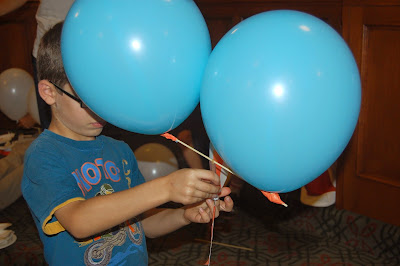Making Penny Batteries
On August 8th, we had a packed story room full of kids 7-12 years old who were here to learn about how electricity works, what kinds of materials conduct electricity, and how to make their own batteries. First, we viewed a slideshow that explained concepts like electric current (the movement of electrons from atom to atom) and the history behind the making of the first battery in 1800 by Alessandro Volta:
Then I gave everyone an envelope with some squares of matboard (like what artists use as the backing and framing for prints and drawings), an LED diode, and five pennies, two of which I sanded for each child in advance of the class. The kids had to sand two more pennies and leave the 5th penny alone, while letting the squares of matboard soak in some kind of solution.
Why sand the pennies? Because all pennies made after 1982 are made with mostly zinc and just a little bit of copper. Sand the copper off of one side, and you now have the two metals Volta used to make the first battery.
They could choose from several different solvents: baking soda (the best batteries had high baking soda content because of its high salt content), sugar (not as good), lemon juice, corn starch, Lawry's seasoned salt (not as salty as you might think), and other ingredients. By accident I left my bottle of vinegar; wish I had remembered it!
Why the salty solution? Because salt molecules help electrons to flow in a stronger current in water. Pure water (which doesn't exist) wouldn't conduct much electricity, but when those matboard squares are soaked in very salty water, the chemical foundation is there for a reaction to occur that will exchange electrons and make an electric current.
By sanding the pennies down on one side until their zinc centers showed, and stacking them with wet (but not drippy) matboard squares soaked in salty water, we were able to recreate Alessandro Volta's first battery, which he made from copper and zinc discs and cloth soaked in salty water, and generate enough electricity to light an LED.
Trying this at home? Not everyone's batteries worked at our workshop, but here are some things to keep in mind:
1. Make sure you stack your pennies with the zinc side up, and top your pile with the unsanded penny (which has copper all around)
2. Make sure your pennies have been sanded all the way--you want your zinc side to have hardly a speck of copper left
3. Make sure the edges of your salty matboard squares are not touching. The battery's chemical electrical current can only be sustained if materials are alternating in the right order and not out of order, and not touching any other pieces.
4. Make sure your LED diode has the positive leg touching the top (unsanded penny) and the negative leg on the bottom. Both legs will be touching copper but the copper metals will be differently charged.
For more tips, check out the video at https://www.exploratorium.edu/snacks/penny-battery.
Then I gave everyone an envelope with some squares of matboard (like what artists use as the backing and framing for prints and drawings), an LED diode, and five pennies, two of which I sanded for each child in advance of the class. The kids had to sand two more pennies and leave the 5th penny alone, while letting the squares of matboard soak in some kind of solution.
Why sand the pennies? Because all pennies made after 1982 are made with mostly zinc and just a little bit of copper. Sand the copper off of one side, and you now have the two metals Volta used to make the first battery.
They could choose from several different solvents: baking soda (the best batteries had high baking soda content because of its high salt content), sugar (not as good), lemon juice, corn starch, Lawry's seasoned salt (not as salty as you might think), and other ingredients. By accident I left my bottle of vinegar; wish I had remembered it!
Why the salty solution? Because salt molecules help electrons to flow in a stronger current in water. Pure water (which doesn't exist) wouldn't conduct much electricity, but when those matboard squares are soaked in very salty water, the chemical foundation is there for a reaction to occur that will exchange electrons and make an electric current.
By sanding the pennies down on one side until their zinc centers showed, and stacking them with wet (but not drippy) matboard squares soaked in salty water, we were able to recreate Alessandro Volta's first battery, which he made from copper and zinc discs and cloth soaked in salty water, and generate enough electricity to light an LED.
Troubleshooting Tips
Trying this at home? Not everyone's batteries worked at our workshop, but here are some things to keep in mind:
1. Make sure you stack your pennies with the zinc side up, and top your pile with the unsanded penny (which has copper all around)
2. Make sure your pennies have been sanded all the way--you want your zinc side to have hardly a speck of copper left
3. Make sure the edges of your salty matboard squares are not touching. The battery's chemical electrical current can only be sustained if materials are alternating in the right order and not out of order, and not touching any other pieces.
4. Make sure your LED diode has the positive leg touching the top (unsanded penny) and the negative leg on the bottom. Both legs will be touching copper but the copper metals will be differently charged.
For more tips, check out the video at https://www.exploratorium.edu/snacks/penny-battery.









Comments
Post a Comment